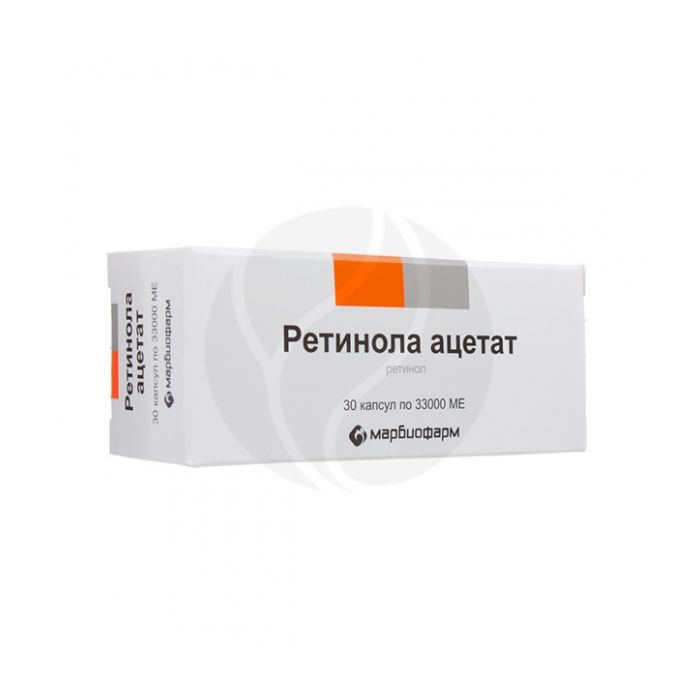Retinol acetate (Vitamin A) capsules 33000ME, No. 30
Expiration Date: 05/2027
Russian Pharmacy name:
Ретинола ацетат (Витамин А) капсулы 33000МЕ, №30
Ichthyosis
hyperkeratosis,
seborrheic dermatitis,
psoriasis,
pyoderma,
atopic dermatitis,
neurodermatitis,
eczema,
frostbite,
burns,
erosion,
ulcers
cracks,
skin atrophy after prolonged use of GCS.
Retinol acetate is taken orally. Therapeutic doses for mild and moderate avitaminosis: for adults - up to 33,000 IU per day, for hemeralopia, xerophthalmia, retinitis pigmentosa - 50,000-100,000 IU per day. Children - 1000-5000 IU per day, depending on age. For skin diseases: adults - 50,000-100,000 IU per day, children - 5,000-10000-20,000 IU per day.
1 capsule contains retinol acetate 33 thousand IU
Hypervitaminosis A,
I trimester of pregnancy,
acute inflammatory skin diseases,
hypersensitivity to the components of the drug.
pharmachologic effect
Dermatoprotective agent. Retinol acetate stimulates skin regeneration, enhances the division of skin epithelial cells, inhibits keratinization processes, and prevents the development of hyperkeratosis. Local action is due to the presence of specific retinol-binding receptors on the surface of epithelial cells.
Indications
Ichthyosis
hyperkeratosis,
seborrheic dermatitis,
psoriasis,
pyoderma,
atopic dermatitis,
neurodermatitis,
eczema,
frostbite,
burns,
erosion,
ulcers
cracks,
skin atrophy after prolonged use of GCS.
Contraindications
Hypervitaminosis A,
I trimester of pregnancy,
acute inflammatory skin diseases,
hypersensitivity to the components of the drug.
Application during pregnancy and lactation
Retinol acetate is contraindicated for use in the first trimester of pregnancy. During lactation (breastfeeding) it is not recommended to apply to the skin of the mammary glands.
Special instructions The teratogenic effect of increased doses of retinol persists even after the termination of its intake, therefore, it is recommended to plan pregnancy when using the drug only after 6-12 months.
Composition
1 capsule contains retinol acetate 33 thousand IU
Method of administration and dosage
Retinol acetate is taken orally. Therapeutic doses for mild and moderate avitaminosis: for adults - up to 33,000 IU per day, for hemeralopia, xerophthalmia, retinitis pigmentosa - 50,000-100,000 IU per day. Children - 1000-5000 IU per day, depending on age. For skin diseases: adults - 50,000-100,000 IU per day, children - 5,000-10000-20,000 IU per day.
Side effects
Local reactions: increased itching, hyperemia. Possibly: allergic reactions. The occurrence of these side effects requires the abolition of Retinol acetate.
Drug interactions
Estrogens and oral contraceptives containing them enhance the absorption of retinol, which can lead to the development of A-hypervitaminosis. During long-term therapy with tetracyclines, it is not recommended to prescribe vitamin A (the risk of developing intracranial hypertension increases). Retinol should be taken 1 hour before or 4-6 hours after taking colestyramine. Retinol absorption is disturbed by nitrites.
Overdose
In acute hypervitaminosis, severe headache, dizziness are observed; drowsiness, confusion, visual disturbances, convulsions, indomitable vomiting, profuse diarrhea, severe dehydration; on the second day, a widespread rash appears, followed by large lamellar peeling, starting from the face; palpation of long tubular bones is sharply painful due to subperiosteal hemorrhages, changes in bone, soft tissues. In children, acute hypervitaminosis is characterized by anxiety, excitement, insomnia during the first day, sometimes there is drowsiness, fever up to 39 ? C, vomiting, protrusion of the large fontanelle, signs of suffocation.
Treatment: symptomatic; as an antagonist, thyroxine is prescribed, as well as ascorbic acid.
Storage conditions
In a dry, dark place at a temperature not exceeding 25 ? C.
Shelf life is 2 years.

